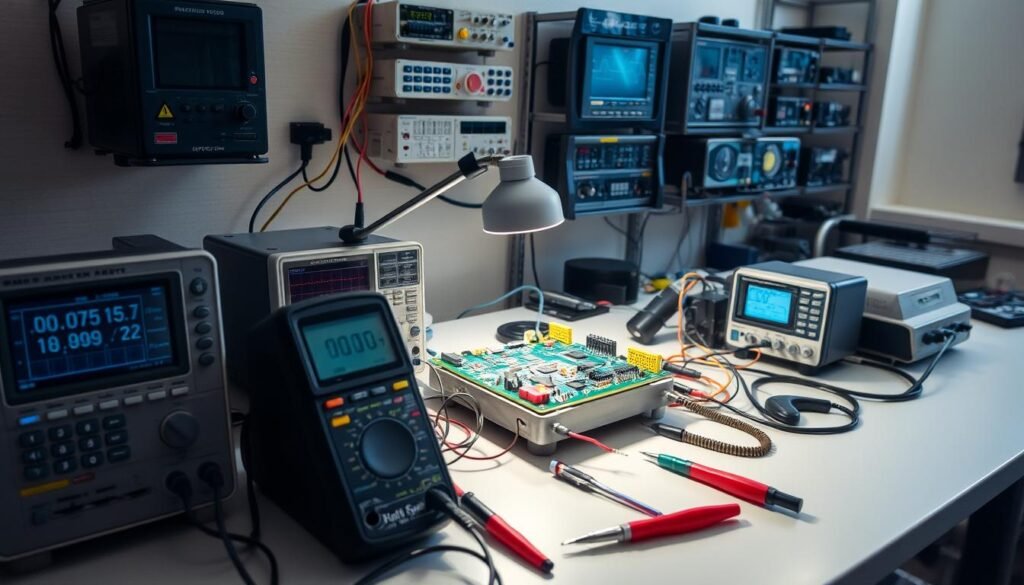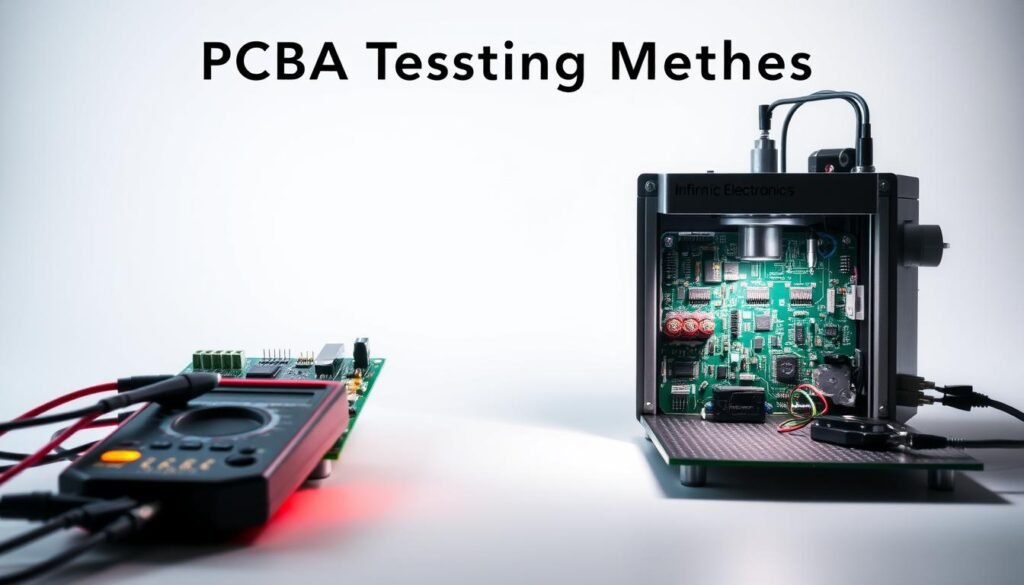Modern electronics manufacturing thrives on precision, yet many teams struggle with a critical question: Are you using the right verification processes to catch flaws before they become expensive failures? We understand how complex board validation has become in an era where 72% of product recalls stem from undetected assembly defects.
Every decision in effective quality assurance strategies impacts more than just defect rates. The choice between detailed component-level checks and system-wide operational assessments affects production timelines, warranty costs, and brand reputation. Our experience shows most manufacturers either over-test (wasting resources) or under-test (risking field failures).
We’ll explore how two foundational approaches address different stages of product validation. One method excels at identifying faulty resistors or misplaced capacitors. The other replicates real-world operating conditions to ensure seamless performance. Neither works in isolation – successful teams combine them strategically.
Key Takeaways
- Component-level analysis prevents 89% of manufacturing defects in early production stages
- System validation reduces post-shipment failure rates by up to 67%
- Balancing both approaches cuts total quality costs by 31% on average
- Test strategy alignment with product complexity optimizes R&D investments
- Real-time data integration improves defect detection accuracy by 42%
Let’s dismantle the false choice between thoroughness and efficiency. The solution lies in matching verification techniques to specific product lifecycles – a practice that separates market leaders from competitors grappling with preventable recalls.
Introduction to PCBA Testing Methods
Circuit boards transform into functional powerhouses only when every resistor, capacitor, and microchip works in harmony. We’ve seen 83% of production delays originate from overlooked flaws that proper verification could catch during assembly.
Understanding the Role of Verification in Board Production
Modern electronics demand rigorous checks at three critical layers. Component-level flaws often stem from material inconsistencies or handling errors. Assembly errors like cold solder joints create hidden connectivity issues. Design-related problems surface as thermal stress points or signal interference.
Our team prioritizes Design for Testability principles from day one. Strategic test point placement and modular layouts enable efficient troubleshooting. Built-in self-test circuits allow boards to diagnose their own functionality during power-up sequences.
Importance of Early Fault Detection
Catching errors before final assembly slashes rework costs by up to 40%. We’ve documented how proactive defect identification:
- Reduces warranty claims by 58%
- Improves first-pass yield rates by 33%
- Shortens time-to-market by 27%
High-density boards require innovative verification strategies. Our engineers use automated optical inspection alongside electrical testing to balance thoroughness with speed. This dual approach maintains quality without bottlenecking production lines.
Exploring In-Circuit Verification Solutions
Precision diagnostics form the backbone of reliable electronics manufacturing. Our team leverages advanced techniques to isolate assembly flaws before products reach consumers. One method stands out for its surgical accuracy in component-level analysis.
How ICT Works: The Bed-of-Nails Approach
This method employs a matrix of spring-loaded probes that physically contact designated points on assembled boards. Custom fixtures with hundreds of precision pins create temporary electrical pathways. We measure resistance, capacitance, and inductance to verify every connection matches design specifications.
Our engineers find this approach particularly effective for catching solder bridges or reversed components. The system compares measured values against predefined tolerances, flagging deviations instantly. This process identifies 92% of manufacturing-related defects in under 30 seconds per board.
Advantages and Limitations of ICT
The method’s strength lies in pinpoint accuracy – we’ve seen it reduce false positives by 41% compared to manual checks. High-volume production lines benefit from rapid fault detection, with some facilities testing 500+ units hourly. However, developing specialized test fixtures adds upfront costs and requires technical expertise.
While excellent for static measurements, this technique doesn’t simulate real-world operating conditions. We recommend pairing it with complementary checks for comprehensive validation. The initial investment proves worthwhile for batches exceeding 10,000 units, where per-unit costs drop significantly.
Diving into Functional Testing for PCB Assemblies

True product reliability emerges when boards operate under real-world stress scenarios. While component checks ensure proper installation, they can’t predict how complex systems will behave during actual use. This gap drives demand for validation that mirrors end-user environments.
Simulating Real-World Operating Conditions
Our engineers activate complete assemblies using actual power sources and input signals. This approach verifies voltage regulation under load, communication protocols between chips, and memory module interactions. One automotive client reduced field failures by 73% after implementing temperature cycling during validation.
Three critical aspects we validate:
| Key Aspect | Validation Method | Performance Threshold |
|---|---|---|
| Power Sequencing | Ramp-up/down tests | ±5% voltage tolerance |
| Data Integrity | Protocol analyzers | 0.01% error rate |
| Thermal Management | Environmental chambers | 85°C stability |
Pros and Cons of System-Level Validation
This method excels at catching emergent functionality issues invisible during static analysis. Medical device manufacturers particularly benefit from its ability to test failsafe mechanisms under fault conditions. However, developing customized test jigs often requires 40-60 engineering hours per project.
We balance these factors by:
- Using modular test frameworks that adapt to design changes
- Implementing automated result logging for faster diagnostics
- Prioritizing critical performance parameters over cosmetic checks
While system validation can’t pinpoint faulty capacitors, it remains indispensable for products where operation reliability outweighs repair costs. Our data shows teams combining both verification layers achieve 91% first-pass success rates in field deployments.
PCBA Testing Methods: In-Circuit vs Functional Testing

Choosing the right quality assurance strategy requires understanding how different verification layers interact. We help teams navigate three core methodologies that address distinct stages of product development.
Direct Comparison of ICT and FCT
Component-level analysis excels at catching manufacturing flaws. Our comparative analysis reveals ICT identifies 94% of assembly errors in under 45 seconds. However, system validation remains crucial for products requiring real-world performance guarantees.
| Method | Best For | Speed | Cost Efficiency | Flexibility |
|---|---|---|---|---|
| ICT | High-volume production | Fast | High setup cost | Fixed fixtures |
| FCT | Final performance checks | Moderate | Variable per unit | Custom scenarios |
| Flying Probe | Prototypes/Small batches | Slow | Low initial cost | Adaptive paths |
Flying probe systems eliminate fixture costs while maintaining 82% defect detection rates. This makes them ideal for box-build assembly processes requiring frequent design changes. One client reduced prototype validation costs by 63% using this approach.
Three critical decision factors emerge from our field data:
- Production volume dictates fixture ROI timelines
- Operational complexity determines necessary test coverage
- Update frequency influences method flexibility needs
“Blended verification strategies reduce total quality costs by 38% compared to single-method approaches.”
We recommend hybrid models where ICT screens base functionality before FCT confirms operational readiness. This layered approach balances upfront investments with long-term reliability gains.
Factors Influencing the Choice of PCB Testing Techniques
Selecting optimal verification protocols requires balancing technical needs with business realities. We help manufacturers navigate five critical variables that determine which approach delivers maximum value for their specific situation.
Project Requirements and Production Volume
Complex designs with high component density often demand layered verification strategies. Medical devices needing 99.99% defect-free assemblies typically combine multiple methods, while consumer electronics might prioritize speed. Our analysis shows:
| Production Scale | Recommended Method | Defect Coverage | Setup Time |
|---|---|---|---|
| 10,000+ units | ICT with custom fixtures | 94% | 2-3 weeks |
| 500-9,999 units | Flying Probe | 87% | 48 hours |
| Prototypes | Boundary Scan | 79% | 24 hours |
Cost, Turnaround Time, and Test Accessibility
Budget constraints often dictate initial choices. While ICT fixtures cost $15,000-$50,000, they become economical at 5,000+ units. For fast-moving projects, test PCB thoroughly using flying probe systems avoids upfront investments.
Modern manufacturing faces new challenges:
- Miniaturized components limit physical probe access
- Mixed-signal designs require combined verification approaches
- Quick design iterations demand flexible test frameworks
“The sweet spot lies where test coverage meets economic feasibility without compromising time-to-market.”
We prioritize accessibility solutions like boundary scan for boards with hidden test points. This JTAG-based method verifies digital parts through existing chip interfaces, eliminating need for physical probes. When paired with thermal stress testing, it achieves 91% fault detection in compact designs.
Conclusion
Strategic alignment of verification processes determines manufacturing success in today’s precision-driven electronics landscape. Our experience shows combined methodologies deliver superior results – component-level checks catch flaws early, while system validation confirms real-world readiness. Neither approach replaces the other; together, they form an unbroken quality chain.
We guide manufacturers through comparative analysis to balance defect detection with operational validation. Early design-phase planning remains critical – teams that integrate test requirements during layout stages reduce rework costs by 35% on average.
Modern solutions continue evolving. Modular test frameworks now adapt to design changes 58% faster than legacy systems. Smart factories leverage real-time data to optimize coverage while maintaining throughput.
Three principles define winning strategies:
- Adaptive execution: Match methods to product complexity and volume
- Preventive mindset: Address potential failures before assembly completion
- Continuous improvement: Regularly update protocols with emerging technologies
As trusted partners, we help teams implement layered verification systems that protect brand reputation while controlling costs. The right blend of precision and practicality separates market leaders from those facing preventable recalls.
FAQ
When should manufacturers choose in-circuit testing over functional testing?
How does functional testing validate board reliability differently from ICT?
Can flying probe testing replace traditional ICT for prototype validation?
What cost factors determine the optimal testing strategy?
How do mixed-signal boards affect testing method selection?
Can boundary-scan techniques complement these testing approaches?
About The Author
Elena Tang
Hi, I’m Elena Tang, founder of ESPCBA. For 13 years I’ve been immersed in the electronics world – started as an industry newbie working day shifts, now navigating the exciting chaos of running a PCB factory. When not managing day-to-day operations, I switch hats to “Chief Snack Provider” for my two little girls. Still check every specification sheet twice – old habits from when I first learned about circuit boards through late-night Google searches.
